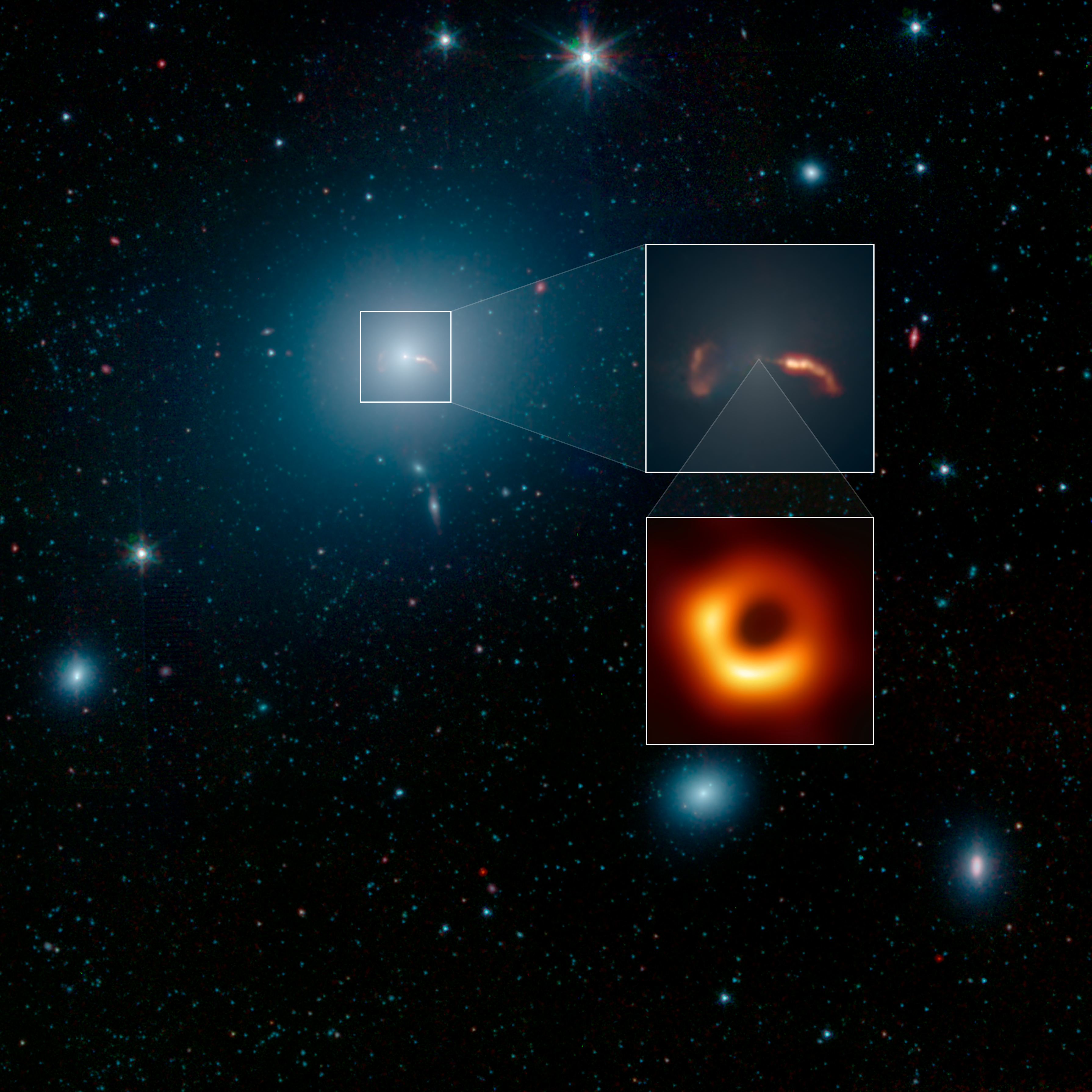|
|
Post by MartinT on Apr 12, 2019 21:43:55 GMT
Gosh, what an incredibly complex process.
|
|
|
|
Post by jandl100 on May 9, 2019 7:21:10 GMT
To put the now iconic M87 black hole image in context, NASA has released an infrared view of the black hole’s host galaxy – M87 – as seen by the Spitzer Space Telescope. astronomynow.com/2019/05/08/spitzer-space-telescope-puts-m87s-black-hole-in-context/A composite image of galaxy M87, showing an infrared view from the Spitzer Space Telescope at left, a magnified look at the galaxy’s central regions, top right, and the Event Horizon Telescope’s enormously zoomed-in radio image of the galaxy’s central black hole, lower right. Image: NASA/JPL-Caltech/IPAC/Event Horizon Telescope Collaboration  And, hopefully, sometime soon the EHT team will be releasing an image of the central black hole in our own Milky Way galaxy. Observations of that were made in the same observing runs as for the M87 image. Silent as the tomb about that at the moment! |
|
|
|
Post by MartinT on May 9, 2019 7:40:58 GMT
I wonder if imaging our own Milky Way's black hole is more difficult due to the stars and material in the way?
|
|
|
|
Post by jandl100 on May 9, 2019 8:31:31 GMT
Maybe so, but the same sort of problems apply to M87 which is a larger galaxy than ours.
But the Milky Way is a spiral, disc galaxy whereas M87 has about the same diameter but is a near perfect sphere and is about 10x as massive.
We're trying to look straight through the gas and dust filled disc of our galaxy, which may well be more spread out and thinner in the spherical M87.
That's the reason the particular radio wavelength was chosen for the observations - there just happens to be a 'window' at that wavelength, pretty much any other wavelengths and the material in the way is opaque, blocking the view of the galaxy's centre. So we may be able to see just as well through our own galaxy's material as through M87's. I'm not sure.
The M87 black hole is much larger than ours, but is much further away. I think the angular size as seen from Earth is about the same.
|
|
|
|
Post by MartinT on May 9, 2019 8:43:46 GMT
Is black hole size roughly proportional to the number of stars in a galaxy?
|
|
|
|
Post by jandl100 on May 9, 2019 10:17:04 GMT
No, I don't think there is such a relationship, the M87 black hole is 1000x as massive as the MW's.
And galaxy mass is dominated by dark matter anyway, whatever that is!
|
|
|
|
Post by jandl100 on Jun 15, 2019 6:08:16 GMT
|
|
|
|
Post by MartinT on Jun 15, 2019 15:30:07 GMT
Gosh, that's some dense reading.
|
|
|
|
Post by jandl100 on Jun 16, 2019 9:42:26 GMT
|
|
|
|
Post by MartinT on Jun 16, 2019 10:33:45 GMT
Astonishing. 5000 light years long! Being in the path of that thing would be suicidal.
|
|
|
|
Post by jandl100 on Jun 16, 2019 15:07:33 GMT
A bit tricky to get out of the way, though, unless you have a warp drive!
|
|
|
|
Post by jandl100 on Sept 26, 2019 9:22:33 GMT
|
|
|
|
Post by jandl100 on Oct 30, 2019 8:16:34 GMT
"This new visualization of a black hole illustrates how its gravity distorts our view, warping its surroundings as if seen in a carnival mirror. The black hole’s extreme gravity skews light emitted by different regions of the disk, producing the misshapen appearance. Bright knots constantly form and dissipate in the disk as magnetic fields wind and twist through the churning gas. Nearest the black hole, the gas orbits at close to the speed of light, while the outer portions spin a bit more slowly. This difference stretches and shears the bright knots, producing light and dark lanes in the disk." NASA Goddard
Credit: NASA’s Goddard Space Flight Center/Jeremy Schnittman
|
|
|
|
Post by Slinger on Oct 30, 2019 14:03:26 GMT
So it turns out that The Eye of Sauron was a black hole...
|
|
|
|
Post by jandl100 on Apr 29, 2022 13:34:32 GMT
|
|
|
|
Post by Slinger on Apr 29, 2022 13:44:39 GMT
I think "small supermassive black hole" may be my new favourite oxymoron.
|
|
|
|
Post by jandl100 on Apr 29, 2022 14:00:21 GMT
It is quite tiny.
A mere 4 million times more massive than our sun.
It must have been a seriously difficult job, they've been on this for 3 years or more.
|
|
|
|
Post by MartinT on Apr 29, 2022 14:23:25 GMT
I think "an object 1 millimeter in size from a distance of 13,000 kilometers away" captures the scale quite nicely.
|
|
|
|
Post by jandl100 on Apr 29, 2022 14:28:50 GMT
Ah, so there's no point in getting my binoculars out on the next clear night?
Mind you, I'd need to be in the southern hemisphere as well.
|
|
|
|
Post by jandl100 on May 12, 2022 13:57:14 GMT
Say "Hi" to the supermassive black hole at the centre of our galaxy.
|
|